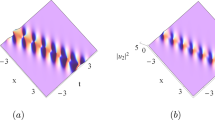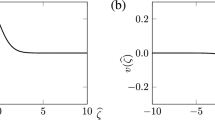Abstract
The article considers questions of the stability of the equilibrium states of a liquid which absorbs light. Threshold values are found for the intensity of the light in the problem of the stability of the equilibrium of a liquid in a square cavity with three thermally insulated walls. A steady-state integro-interpolation scheme is presented for the numerical calculation of problems of photoabsorption convection. The propagation of light waves in absorbing media is accompanied by the dissipation of radiant energy. In heavy liquids, absorption heating of a substance in the field of a wave may be the reason for the appearance of convection [1–3]. It is important to study the conditions for the appearance and the special characteristics of this type of convection, and its inverse effect on the structure of the light field. The first problem is important when the light beams are regarded only as a source of convection [4], and the second in questions of the directed propagation of light [5] and of self-focusing phenomena [2, 3, 6–10]. For high-energy heat fluxes and a liquid with a strong temperature dependence of its dielectric permeability, the convective self-stress will be very considerable; in this case, both problems are mutually interconnected. The excitation of convection by the absorption of light, without taking account of the inverse effect on the structure of the light beam, was studied numerically in [1, 4]. Equations for photoabsorption convection, taking account of convective self-stress in the Boussinesq approximation and of the geometry of the optics, were formulated in [11]. Several economical finite-difference schemes for solving problems of photoabsorption convection problems in rectangular cavities are discussed in [12]. The present article is devoted to an investigation of the threshold intensities of light for the excitation of photoabsorption convection. The existence of critical intensities of light, above which the mechanically equilibrium states of the liquids absorbing the light become unstable, was demonstrated in [1, 4].
Similar content being viewed by others
Literature cited
B. M. Berkovskii, “Convection excited by light,” Paper read at the All-Union Conference on Aerothermo-optics and Lightguides, Minsk (1969).
G. A. Askar'yan and I. L. Chistyi, “Thermal self-focusing in a light beam with a decrease in the intensity near the axis,” Zh. Éksperim. i Teor. Piz.,58, No. 1 (1970).
G. A. Askar'yan, V. V. Studenov, and I. L. Chistyi, “Thermal self-focusing in a beam with a decreased intensity near the axis,” Usp. Fiz. Nauk,100, No. 3 (1970).
B. M. Berkovskii, “The structure of convection excited by the absorption of light,” in: Investigation of Thermohydrodynamic Lightguides [in Russian], Izd. ITMO Akad. Nauk BSSR (1970), pp. 230–242.
B. M. Berkovskii, O. V. Martynenko, A. M. Zhilkin, and O. N. Porokhov, Thermohydrodynamic Lightguides [in Russian], Izd. Nauka i Tekhnika, Minsk (1969).
A. G. Litvak, “The self-focusing of high-energy light beams, connected with thermal effects,” Zh. Éksperim. i Teor. Fiz., Pis. Red.,4, 341 (1966).
Yu. P. Raizer, “Self-focusing and defocusing, instability and stabilization of light beams in weakly absorbing media,” Zh. Éksperim. i Teor. Fiz.,52, No. 2 (1967).
S. A. Akhmanov, Yu. A. Gorokhov, D. P. Krindach, A. P. Sukhorukov, and R. V. Khokhlov, “Self-focusing of the radiation of a continuous gas laser,” Zh. Éksperim. i Teor. Fiz.,57, No. 1 (1969).
G. A. Askar'yan, and V. V. Studenov, “‘Banana’ self-focusing of beams,” Zh. Éksperim. i Teor. Fiz., Pis. Red.,10, No. 3, 113 (1969).
A. P. Sukhorukov, “Thermal self-stress of intense light waves,” Usp. Fiz. Nauk,101, No. 1 (1970).
B. M. Berkovskii, “Photoabsorption convection,” in: Aero-thermo-optics and Lightguides [in Russian], Izd. ITMO Akad. Nauk USSR, Minsk (1970), pp. 245–248.
B. M. Berkovskii and E. F. Nogotov, “Photoabsorption convection in cavities,” Inzh.-Fiz. Zh.,19, No. 6 (1970).
V. S. Korobkov, Physical Problems in Spectroscopy [in Russian], Izd. Akad. Nauk BSSR, Moscow (1963).
H. L. Hackforth, Infrared Radiation McGraw-Hill (1960).
G. Z. Gershuin, E. M. Zhukhovitskii, and E. L. Tarunin, “Numerical investigation of the convection of a liquid heated from below, Izv. Akad. Nauk BSSR, Prikl. Mat. i Mekhan., No. 6 (1966).
S. H. Davis, “Convection in a box: linear theory,” J. Fluid Mech.,30, Part 3, 465–478 (1967).
A. D. Gasmon, W. N. Pun, A. K. Runchal, D. B. Spalding, and M. Wolfstein, Heat and Mass Transfer in Rectilinear Flows, S. I., Academic Press (1969).
B. M. Berkovskii and E. F. Nogotov, “Numerical Investigation of free convection with heating from above,” Izv. Akad. Nauk SSSR, Mekhan. Zhidk. i Gaza., No. 2 (1970).
A. A. Samarskii, Lectures on the Theory of Difference Schemes [in Russian], Moscow (1969).
Author information
Authors and Affiliations
Additional information
Translated from Izvestiya Akademii Nauk SSSR, Mekhanika Zhidkosti i Gaza, No. 5, pp. 128–135, September–October, 1971.
The authors thank A. V. Lykov for his continuing interest and aid, and G. I. Petrov and V. I. Polezhaev for their useful evaluation of the work.
Rights and permissions
About this article
Cite this article
Berkovskii, B.M., Ivanov, L.P. Threshold excitation of photoabsorption convection. Fluid Dyn 6, 841–848 (1971). https://doi.org/10.1007/BF01013867
Received:
Issue Date:
DOI: https://doi.org/10.1007/BF01013867




